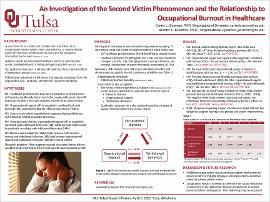| dc.description.abstract | BACKGROUND: Unexpected events or outcomes in healthcare that create considerable harm or lasting damage to a patient are called adverse patient events (Mira et al., 2015). Providers affected by such events are called “second victims.” The current study examined personal and organizational outcomes related to involvement in adverse events including psychological and physical symptoms, burnout, and employee withdrawal behaviors.
METHODS: Participants were recruited through social media sites. The population of interest was healthcare providers who potentially had been involved in an adverse event. Consent to participate was given by 204 individuals of which 127 were current or former healthcare providers. The remaining 77 respondents were excluded from the study.
All measures were self-report and administered online through Qualtrics. All scales demonstrated acceptable internal consistency reliability. First, burnout was measured using the Oldenburg Burnout Inventory (Demourti et al., 2003). Participants were then asked if they had experienced an adverse patient event. Individuals who affirmed having such an experience were considered second victims and remained in the study; participation from other healthcare respondents was complete at that point. Responses to items from the second victim experience and support tool developed by Burlison and colleagues (2017) were collected from the second victims. Factor analytic work and internal consistency reliability analyses resulted in three factors: “personal distress,” “organizational support,” and “withdrawal behaviors.”
RESULTS: Results indicated that second victims had significantly higher rates of burnout (M=3.88, SD=.97) than did other healthcare providers (M=3.46, SD=.84), t(119)=-2.07, p<.05. Results also revealed personal distress was significantly positively correlated with both burnout (r=.56) and withdrawal behaviors (r=.56) while perceptions of organizational support were significantly negatively correlated with both burnout (r=-.46) and withdrawal behaviors (r=-.35). A mediation model tested using Hayes SPSS PROCESS macro revealed the negative relationship between organizational support and withdrawal behaviors was partially mediated by burnout. Percent mediation was 52.9%.
CONCLUSION: This study has important implications for healthcare organizations. Adverse patient experiences were related to higher likelihood of provider burnout and withdrawal behaviors. Perceptions of organizational support, however, were inversely related to these outcomes. Results suggest healthcare organizations should prioritize support mechanisms for second victims to potentially mitigate undesirable employee and organizational outcomes related to adverse patient events. Due to the cross-sectional design of the study, causal relationships between involvement in adverse events and these consequences cannot be assumed however, thus, further research is suggested. | en_US |

